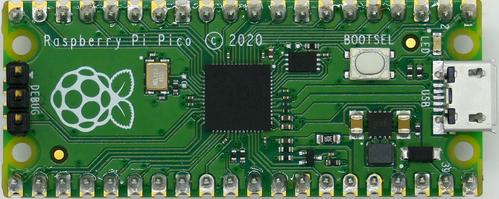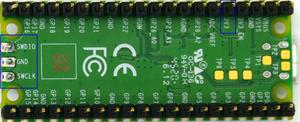Difference between revisions of "Raspberry Pi Pico"
(→RAM Projects) |
|||
| Line 47: | Line 47: | ||
===RAM Projects=== |
===RAM Projects=== |
||
| + | Refer to [[Raspberry_Pi_RP2040#RAM_Projects | RAM Projects for the Raspberry Pi RP2040]]. |
||
| − | *Core0: [[Media:Raspberry_RP2040_Pico_RAM_Core0.zip|Raspberry_RP2040_Pico_RAM_Core0.zip]] |
||
| − | *Core1: [[Media:Raspberry_RP2040_Pico_RAM_Core1.zip|Raspberry_RP2040_Pico_RAM_Core1.zip]] |
||
===QSPI Projects=== |
===QSPI Projects=== |
||
Revision as of 11:48, 11 May 2022
The Raspberry Pi Pico is a Raspberry Pi RP2040 evaluation board. It is the first MCU evaluation board published by Raspberry Pi.
Contents
Features (selection)
- RP2040 MCU
- 2MB on board QSPI flash
- Micro USB-B 1.1
- Temperature sensor
- On board LED
- external debug connector pads
For further information please refer to the Rapberry Pi Pico web page
Setting up with J-Link
The Raspberry Pi Pico evaluation board comes with an external SWD debug connector (3 pins: SWCLK, GND, SWDIO). To set the board up with J-Link, the following steps are required:
- Solder a 3-pin pin strip to the debug connector pads.
-
Solder a pin Strip to the GPIO pads of the evaluation board. The relevant pad is Pad 36 (3V3(OUT))
-
Connect the J-Link to the evaluation board, using jumper wires as follows:
Pin RP Pico Pin J-Link Signal "DEBUG" "SWCLK" 9 SWCLK "DEBUG" "GND" 4 GND "DEBUG" "SWDIO" 7 SWDIO "3V3" Pad 36 1 VTref
Note: For a more reliable, simpler solution, the SEGGER Flying Wire Adapter is recommended.
Example Projects
To run the following example projects the following prerequisites need to be met:
- J-Link software V6.98c or later
- J-Link HW revision 11 or later (J-Link Edu Mini and J-Trace Pro V1 or later also supported)
- SEGGER Embedded Studio V5.40c or later
- Ozone V3.22c or later
RAM Projects
Refer to RAM Projects for the Raspberry Pi RP2040.

